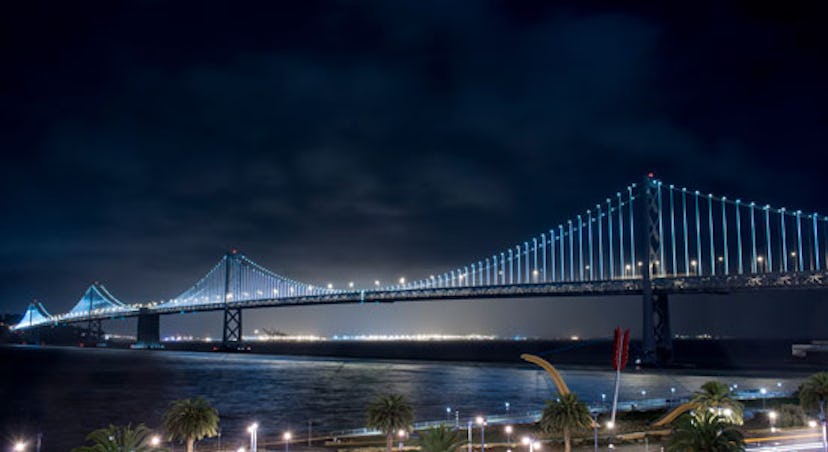Don’t Miss: Leo Villareal’s The Bay Lights
Last night, with a single keystroke, Leo Villareal illuminated the largest LED light sculpture in the world, an installation of 25,000 individually programmed lights trimming 300 vertical cables of San Francisco’s Bay Bridge.

Last night, with a single keystroke, Leo Villareal illuminated the largest LED light sculpture in the world, an installation of 25,000 individually programmed lights trimming 300 vertical cables of San Francisco’s Bay Bridge. It being San Francisco, in spring, it was raining. So the ceremonious moment, an $8 million marvel of modern engineering, took place under a $20 umbrella. No matter. Crowds packed the waterfront to see the lights shift and sparkle, in patterns that sometimes explicitly resembled the surroundings—a school of fish, a cascade of rain—but more often offered abstractions. “It’s like fireworks,” one viewer suggested, huddling with strangers under a café heater. “Oh, that’s very Blade Runner,” another commented, likening the sudden appearance of swift bubbles of light to the flying cars in Ridley Scott’s 1982 film.
It’s this sort of talk that Villareal says he finds exciting. He describes the artwork as a “digital campfire,” a place for people to gather and discuss. (San Francisco anticipates that 50 million people will visit “The Bay Lights” before it closes in March 2015, bringing the local economy $97 million.) “It’s about creating a talking point,” Villareal said. “You’re interacting with people you never would have talked to and creating a community.”
For the 46-year-old artist, that’s becoming something of a habit. His light installation, Hive, made New York’s Bleecker Street subway station an unexpected destination when it opened this past August 2012, followed quickly by his 30-foot sculpture, Buckyball, in Madison Square Park in October.
Construction of “The Bay Lights”, which began in September, required 10 electricians to climb up to 500 feet in the air five days a week, working overnight to avoid traffic. The electricians completed their work in January, and Villareal came to town to test it. The experience, he says, was “overwhelming.”
“You work so hard making these things happen. When you get to the moment of turning it on, that’s the real thrill,” said Villareal. “That’s when my work really started, the spending time with it, figuring it out, tuning, and adjusting.”
As he began the two-month process of fine-tuning the piece, he gained many admirers. Locals gathered to watch the artist programming light sequences on his laptop. Private donors poured in funds; so far they’ve raised $6 million of the necessary $8 million. Tech companies, such as Apple and Autodesk, expressed interest in developing further tools for Villareal. And the hashtags #baylights and #thebaylights blew up as passerbys tried to capture the previews. Unfortunately for the social media age, the sheer scale of the sculpture, as well as its mutability (the work is programmed so that no sequence will ever repeat) makes it difficult to take in remotely. For Villareal, that’s as it should be.
“The piece really is almost undocumentable, in a way,” he says, “You can’t capture what it’s like to sit in front of it. So, that’s very interesting to me. Lots of people try, but it’s really about being present with the piece. I love how it insists on people coming and seeing it.”
The Bay Lights will be displayed from dusk until 2 a.m. until March 2015; thebaylights.org